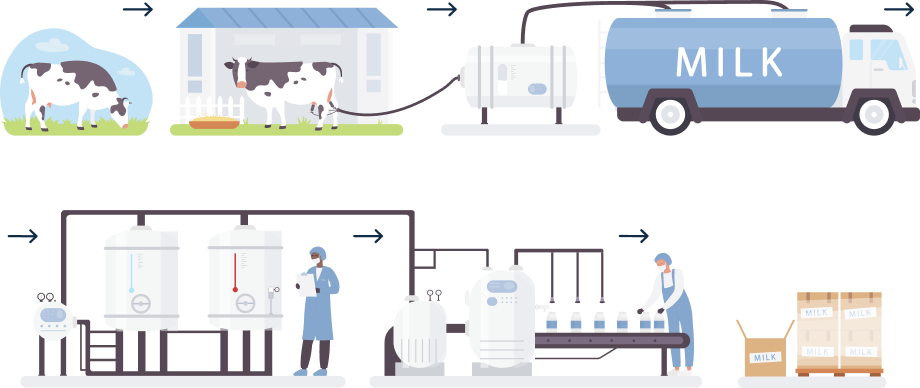What do cows eat?
Ireland is known for a strong grass-based system for beef and dairy. The majority of livestock farmers opt for a grass-based diet due to the benefits it brings for animal health and farm economics.
The requirements to be considered a Bord Bia quality assured grass-based system are:
- 90% of cattle diet over its lifetime must be based on fresh grass or grass based derivatives (e.g. silage)
- 220 average days a grass (40 day allowance for poor weather or soil type)
Overwinter, the most cost effective feed is good quality silage. Silage is fermented grass that is harvested in summer and either baled or added to a silage pit. When making silage, best practice is to cut when dry, wilt if possible and cover quickly. Silage quality is measured in a number of ways, one being DMD or dry matter digestibility. A DMD of 70% or more is considered good.
Teagasc on DMD:
‘The higher the digestibility (DMD) of a grass silage, the more efficiently animals will use it and the greater the amount of milk or meat they will produce. Grasses with a lot of stem, seed-heads or dead vegetation are much less digestible than those with a greater proportion of leaf. The importance of highly digestible silage is greater when the price of concentrates is high’.
Dairy Breeds
Montbéliarde
Montbéliarde
Fleckvieh
Fleckvieh
Norwegian Red
Norwegian Red
Brown Swiss
Brown Swiss
Holstein Friesian
Holstein Friesian
Are the highest producing dairy animal in the world. They can be found on every continent and in almost every country. They give a high milk yield with a medium butter fat percentage.
British Friesian
British Friesian
Are a well-built animal with a large appetite. They are a dual purpose breed and can have fast growth rates for finishing as beef. They give very high milk yields when well nourished and housed.
Jersey
Jersey
Ayrshire
Ayrshire
Kerry Cow
Kerry Cow
Milking Process
Cows begin to produce milk once they have given birth to their first calf. Typically a cow will follow a 10 months milking and 2 months dry cycle. Many farmers milk twice per day, typically in the morning and evening.
A typical milking process:
Cows are brought into the parlour and are secured in individual stalls -> The udder is checked for injuries or infection -> The teats are then cleaned before attaching the cluster or milk claw. The milk claw contains four soft rubber suction cups that pulsate to draw the milk out of the udder -> The milk then travels through a series of tubes and is collected in a large container called a bulk tank. The same process is carried out for each cow. The bulk tank is kept at 2-4℃ -> The milk is collected by a milk truck every 24 to 48 hours depending on the level of production.
Milk Quality Standards
The limits for the below milk quality standards are set by the processors (e.g. Glanbia; Centenary Thurles) and are written into contract with individual farmers.
TBC A low total bacteria count (TBC) is reflective of good hygiene standards during the milking process and the storage of milk. This includes the cleanliness of milking equipment which should be ensured by using an approved detergent with hot water to disinfect the equipment after milking.
SCC A low somatic cell count (SCC) is reflective of good mastitis control with the herd. Mastitis is an infection of the udder that causes pain, swelling of the udder and causes the milk to appear clotted, watery or off in colour.
Thermoduric bacteria A milk processor will check the thermoduric bacteria count of milk due to the difficulties these heat resistant bacteria can have for milk quality.
Other Standards
Temperature Milk should be stored at 6℃ or slightly lower. This temperature inhibits the growth (multiplication) of bacteria.
Antibiotics The use of antibiotics is only permitted in livestock if necessary for their health. Antibiotics are not routinely permitted as preventative measures. If antibiotics are used, there are withdrawal periods required before a cow's milk can re-enter the food chain. Processors screen for antibiotic residue in milk.
Excess water The price of milk is determined by the milk solid % (fat and protein). Excess water and reduced milk solids will drive down the price a farmer is paid for their milk. There are many influencing factors for milk solid %, including quality of feed, genetics, time of year and age of cow.
Sediment Milk is also checked for unwanted particles suspended within the milk. All milk should arrive at the creamery uncontaminated.

What’s in my glass (Nutrition)
Milk is a suspension of protein, fat and other solids in water. The composition of milk varies depending on the breed of cow. Milk contains many nutrients that are important for the body.
Protein - a key macronutrient nutrient for muscle growth and bone development.
Fat - a key macronutrient for energy stores and absorption of fat soluble vitamins.
Carbohydrates - a key macronutrient for energy. Lactose is the carbohydrate found in milk which can help the body to absorb certain minerals. Those that are lactose intolerant should consume lactose free milk.
Minerals - calcium and phosphorus for bone development and healthy teeth; potassium for a normal functioning nervous system.
Vitamins - vitamin B2 helps keep skin healthy and protects vision; B5 for normal metabolism and energy; B12 for red blood cell formation and normal immune system function.